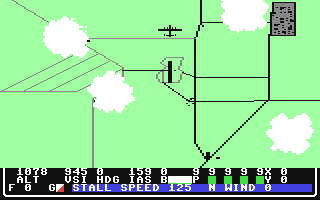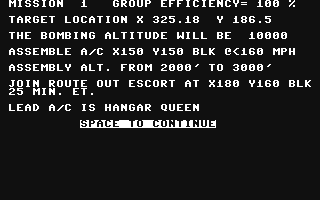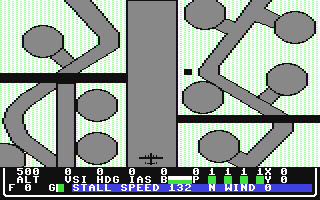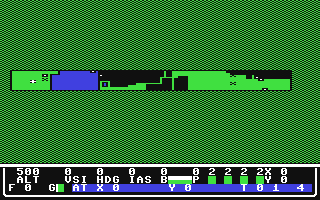| |
|
|
|
 |
|
| Welcome
to Game of the Week! Each week there will be a
new featured game on this page. The game may be good,
average or diabolically bad, it really doesn't matter!
Just look at the pics, read the text and enjoy the nostalgia!
:-) Game of the Week! is open to contributions so if you
would like to contribute
a game article for this page you're more than welcome
to! Every article we receive will be considered! |
|
|
B-24
1987 Strategic
Simulations Inc.
Programmed
by John R. Gray
|
| |
| Most
text of the present article comes from the review published
in the thirtieth issue of the British C64 magazine ZZAP!64
(street date: September 10th, 1987). |
| |
|
STYLE
OR SUBSTANCE?
Weary
and battle-stained messengers tramped across the war-torn
wastes of North Oxford, ploughing through the battle
lines of Japanese tourists and French school parties
to bring despatches announcing my finals results. Yes
-- I got a second like everyone else. Now I've retreated
from the centre of the city, the bit where all the nice
buildings and the tourists are, to be a great writer
and starve in a garret. I've started my next novel and
I've all sorts of ambitious plans to write for television,
so watch out for my name on the screen!
Now
to work . . . the conflict between Presentation and
Content in wargames is an interesting one, because war
and strategy games are the only kind of computer software
which can tolerate any separation between them. And
it does seem to be a conflict; I have become uncharitably
suspicious of games which load up looking polished and
sporting design gimmicks, as one of this month's games.
Blitzkrieg, does. I'm beginning to wonder whether
it's a question of attitude on the part of the game
designers. 'Real-Ale' wargame writers signify their
intention to present a serious piece of complex strategic
gameplay by swathing it in a clumsy order frame, which
just barely escapes hampering the playability, and dressing
it in such unappealing graphics that none but those
who take these things suitably seriously would ever
be attracted to play their game. Commercial software
houses, on the other hand, imagine that even when playing
a wargame, what the average buyer really wants is another
something 'em up, so they produce a piece of software
to the high standards common in the arcade genre, which
turns out to be a glossy but ineffective imitation of
a real wargame. This may well be an over-simplification,
but I'm thinking of Battlecruiser and Blitzkrieg
as relative examples of each approach.
In
other genres, technical advances have always been welcomed
as actual steps forward. The impact of presentation
in an arcade game is always very strong, and can genuinely
affect the value of the game. There was a time about
two years ago, when I first came to computer gaming,
when the programming and presentation advances over
the proceeding 18 months had been amazing. Spectrum
game collectors could look at previously acclaimed programs
like Manic Miner and then at the recent masterpieces
like Knight Lore, Alien 8 and Lords
of Midnight and rejoice. Every new issue of CRASH
and the late lamented PCG seemed to contain a blockbusting
review of major breakthrough, and truly these were wondrous
times to be alive in.
These
breakthroughs boiled down to programming and presentation.
Knight Lore was not intrinsically a better game
than Manic Miner (and some people would argue
strongly to the contrary!), except that it created a
novel illusion of three dimensional solidity which most
people then found added a great deal to their enjoyment
The total aesthetic appeal of the program was greater.
Nobody complained that the revolutionary graphics and
the slick programming made it commercial and glib, though
later Ultimate productions certainly had plenty of abuse
of this nature heaped upon them.
Strategy
and wargames are not the same as arcade games because
the base of their play is different, as I've tried to
explain in past reviews. Wargames in particular do not
generally attempt to create their own fantasy world
-- except in special Instances -- they are interfaced
with reality, and expect the player to consider them
very much as a means to the end of simulation, whether
of a battle or a war machine. It is because they are
less self-contained that they can get away with shoddy
presentation, but still they reduce their aesthetic
appeal and so, for no reason, they reduce their impact.
Commodore
disk-based games in particular have no excuse, for they
are not hampered by very great memory restrictions.
Perhaps we're past the era of real technical programming
advances, and perhaps it's unrealistic to hope for something
of the sort to arrive in the form of a wargame. Wargame
writers seem to be great traditionalists. But it's not
too much to ask for a neat screen display, an attractive
character set, clear and (if possible) imaginative-looking
unit counters, and some orders system which doesn't
take half an hour to manipulate. Music is not necessary.
.
|
| |
|
|
 |
|
B-24
FLIGHT SIMULATOR
SSI,
£14.99 cass,
£19.99 disk
|
|
|
Machine
simulations are, when you think about it, at one extreme
of the wargaming scale. Some games allow you to move
armies across continents over a period of months, some
ask you to direct divisions in a single battle, and
a few let you position individual men in combat. Simulation
games however put you directly behind the gunsight,
and let you press the buttons -- they represent a cross
between the action of arcade gaming and the ideas of
strategy gaming.
B-24
Flight Simulator and Combat Simulator, as it's more
or less called (hardly a memorable title I trust you'll
agree), puts itself firmly in the wargaming camp. A
more appropriate title would be something like 'Mission
Over Ploesti'. Although the operation of the gameplay
involves flying a B-24 bomber at a level of some mechanical
detail, the focus is firmly fixed on the object of the
flight and most of the excellent documentation concentrates
on the target rather than the machine. This is an unusual
emphasis for a flight simulator, but it turns out to
be what makes B-24 more playable and absorbing
than flight simulators usually are. It achieves this
by cutting out what is normally considered to be an
essential element in this sub-genre, the computer-generated
impression of flight itself.

During
the Second World War, the town of Ploesti in Rumania
provided Hitler with most of his oil for the Axis War
effort. It was reckoned that if the numerous oil refineries
around Ploesti could be bombed into non-productive oblivion
then Hitler's war machine would creak to a rusty stop.
Accordingly, both the British and American air-forces
launched a series of bombing raids on Ploesti, which
was once known as the 'while town of black gold'. After
339 bombers had been shot down over there during the
25 attacks, it was called 'the bombers' graveyard' by
Allied air crews. The campaign game allows the player
to fly the 19 missions attempted by the (presumably
American) 460th Bomb Group, which was based at Spinazolla
near the East coast of Italy. Essentially the player
is fighting history: the aim is to get the production
of oil refineries down lower than the historical figure
after the B-24s had finished their attack. Doing better
than the original crews means that you will shorten
the Second World War.
Thoughtfully,
the game also provides the player with an easy introductory
mission; bombing another town, Mostar, which is right
on the west coast of Yugoslavia, and is therefore easy
to reach from Spinazolla. There is also a particularly
difficult individual mission to Bucharest, which is
so far from base that it requires efficient flying to
make it there and back without carrying so much fuel
that there's no room for a sufficient number of bombs.

The
screen display does not show the interior of a cockpit,
as one would usually expect of a flight simulator. Instead,
the B-24 is viewed from above as an extremely basic
aeroplane shape, flying over a pleasantly drawn and
detailed landscape. The first 'screen' shows the landing
strip, viewed at close range, but as soon as the plane
lifts off, the player finds himself looking down at
the ten-mile square surrounding the airbase from in
indeterminate height. Although, of course, the aeroplane
can move up and down tens of thousands of feet, there
is no visual representation of three-dimensional movement
. . . and therefore no sensation of flying at all. And
although the stick drawing aeroplane does point itself
in the right general direction when the player changes
its bearing, it does so very inexactly. Information
about the plane's precise location is gained from the
numbers on the instrument panel, which yet again makes
no attempt at visual realism. There are no blurred dials
or unhelpful lights in this flight simulator. All instruments
give their readings in neatly arranged numerical form,
and the main difficulty in learning how to fly the plane
is remembering which of these numbers are important.

All
this may be seen as a drawback for those looking for
a flight simulator -- but for those looking for a game,
I think the compromises are worth it for the sake of
clarity. The actual mechanism of the B-24 is authentically
simulated and the plane reacts noticeably to carrying
extra weight, to wind speeds, and to limping along with
three of its engines out and one of its wings on fire.
The
relevant parts of Italy, Yugoslavia and Rumania are
divided into ten-by-ten mile squares, filled either
with mountains, land, sea or hill. These terrain types
are important insofar as it's best to fly at a sufficient
altitude to avoid crashing into them. One screenful
represents one square on the glossy card map provided,
so if your instruments are taken out in combat it's
possible to navigate 'by hand'. Normally, pressing a
key will bring up a navigator's report, telling you
precisely where you are, with co-ordinate's exact to
two decimal places.

When
playing the campaign game, the player has to choose
a mission to any one of the 12 refineries situated around
Ploesti. Daily production figures are displayed on the
campaign screen, and as they are taken out their production
will drop. Having chosen the target, the aim is then
to get to Ploesti -- balancing the amount of fuel taken
with a sufficient number of bombs.
Before
you can head off Ploesti-wards, you have to assemble
your squadron. This involves circling above the airfield
at the right height, keeping up the correct speed; if
any bombers drop out, that will be one less for the
mission. There's also a fighter escort to pick up at
a specified location, to protect the bombers from 'bogeys'
on the journey out. Near the target, if you get there
in time, you pick up a bombing escort. To bomb successfully
you have to be exactly on the right course -- something
which requires a lot of fine manoeuvring. A strong wind
can make it very difficult to attain and maintain any
course at all. Bomb sights, which come into operation
once you open the bomb doors, enable you to fine-tune
your position and send the bombs away almost exactly
over the target.

|
| |
|
It's concentrating on the mission that gives this
game atmosphere, and the superb documentation
-- there's a separate book full of information
about Ploesti, including an extract from a B-24
pilot's autobiography -- enhances the sense of
involvement which is invited by the straightforward
gameplay. A minor complaint is the irritating
drone of the plane's engines which keeps going
throughout the flight, though when you stall or
run out of fuel, the silence that ensues is suitably
ominous -- and you can always turn it down. The
difficulty level is adjusted by altering a set
of parameters such as engine reliability and whether
you want any weather or not, so the challenge
is extensive.
Maybe
it would get boring eventually flying back and
forth to Ploesti if you really played the game
to death, but you have the option of bombing Bucharest
for target practice, and the fact is that this
flight simulator, unlike many, encourages persistence
and playing until the early hours.
.
|
|
|
Presentation 75%
Quite
a 'solid' appearance and thankfully no disk access
pauses, but the program seems sluggish to respond
to the joystick and keypresses.
Graphics
70%
The
landscape is pleasant, with aerially-visible features
like roads convincingly marked -- but the plane
itself has about three frames of animation.
Rules
95%
The documentation is a major feature,
containing a large amount of information about
Ploesti and the missions that were sent out over
it.
Authenticity
93%
Despite the lack of 'real' flight
simulation graphics, it's easy to get absorbed
in the historical atmosphere. Also, the plane's
dynamic reactions to flight conditions are very
credible.
Playability
89%
Once you've got the hang of it,
it's difficult to stop.
Overall
90%
A convincing and absorbing game,
which may well appeal to those who don't usually
like conventional flight simulators.
.
|
|
|
| |
 |
|
Htmlized
by Dimitris
Kiminas (9 Oct 2005)
Only the first from the above screenshots existed in
the original review.
Other
"Games of the Week!"
Home
|
| |
|
|
|